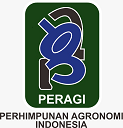Shelf Life of Biofilm Producing PGPR Liquid Inoculants in Different Enriched Media Composition
Abstract
Selecting a carrier material compatible with microbes is crucial for ensuring the quality of biofertilizers. This research aimed to identify a carrier material that could sustain the population of inoculants from dryland (including Delftia tsuruhatensis strain D9, Delftia sp. strain MS2As2, and Bacillus sp.) for a specified period. After conducting the study, it was found that a formulation of 3% molasses, 3% glycerol, 1% potassium sorbate, and 1% Tween-20 enriched with 1% nutrient was the most effective carrier material in maintaining the number of live inoculant cells. This formulation was able to sustain the population of inoculants up to the twelfth week, with a total population of 21.60 × 108 CFU.mL-1 with pH value of media is 5.29, and fulfilled the main criteria for biofertilizers.
Keywords
Full Text:
PDFReferences
Allouzi, M. M. A., Allouzi, S. M. A., Keng, Z. X., Supramaniam, C. V., Singh, A., & Chong, S. (2022). Liquid biofertilizers as a sustainable solution for agriculture. Heliyon, 8(12), e12609. https://doi.org/10.1016/j.heliyon.2022.e12609.
Aloo, B. N., Mbega, E. R., Makumba, B. A., & Tumuhairwe, J. B. (2022). Effects of Carrier Materials and Storage Temperatures on the Viability and Stability of Three Biofertilizer Inoculants Obtained from Potato (Solanum tuberosum L.) Rhizosphere. Agriculture (Switzerland), 12(2). https://doi.org/10.3390/agriculture12020140.
Bal, H. B., Nayak, L., Das, S., and Adhya, T. K. (2013). Isolation of ACC deaminase-producing PGPR from rice rhizosphere and evaluating their plant growth promoting activity under salt stress. Plant and Soil, 366(1–2), 93–105. https://doi.org/10.1007/s11104-012-1402-5.
Basu, A., Prasad, P., Das, S. N., Kalam, S., Sayyed, R. Z., Reddy, M. S., & Enshasy, H. El. (2021). Plant growth promoting rhizobacteria (Pgpr) as green bioinoculants: Recent developments, constraints, and prospects. Sustainability (Switzerland), 13(3), 1–20. https://doi.org/10.3390/su13031140.
Bhavya, K. (2017). Comparative Study on Quality Parameters and Viability of Carrier and Liquid Biofertilizers. International Journal of Pure & Applied Bioscience, 5(4), 1702–1709. https://doi.org/10.18782/2320-7051.5706.
Cavite, H. J. M., Mactal, A. G., Evangelista, E. V., and Cruz, J. A. (2021). Growth and Yield Response of Upland Rice to Application of Plant Growth-Promoting Rhizobacteria. Journal of Plant Growth Regulation, 40(2), 494–508. https://doi.org/10.1007/s00344-020-10114-3.
El-Ramady, H., El-Ghamry, A., Mosa, A., & Alshaal, T. (2018). Nanofertilizers vs. Biofertilizers: New Insights. Environment, Biodiversity and Soil Security, 2(1), 40–50. https://doi.org/10.21608/jenvbs.2018.3880.1029.
Figueireo, Marcia do Vale Barreto, Seldin, L., Fernando, A. F., & Mariano, R. de L. R. (2011). Plant Growth Promoting Rhizobacteria : Fundamentals and Applications. 18, 251–272. https://doi.org/10.1007/978-3-642-13612-2.
Garcha, S., Kansal, R., & Gosal, S. K. (2019). Molasses growth medium for production of Rhizobium sp. Based biofertilizer. Indian Journal of Biochemistry and Biophysics, 56(5), 378–383.
Gopi, G. K., Meenakumari, K. S., Nysanth, N. S., & Subha, P. (2019). An optimized standard liquid carrier formulation for extended shelf-life of plant growth promoting bacteria. Rhizosphere, 11, 100160. https://doi.org/10.1016/j.rhisph.2019.10
Goudar, G., Sreenivasulu, G., Kumbar, B., & Nagaraj, H. (2017). Plant Growth Promotional Activity of Newly Developed Formulation of Azospirillum on Maize. International Journal of Current Microbiology and Applied Sciences, 6(12), 370–380. https://doi.org/10.20546/ijcmas.2017.612.045.
Jin, Q and Mattew, F.K. 2018. pH as a Primary Control in Environmental Microbiology : Thermodynamic Perspective. Frontiers in Environmental Science, 6(21), 1‒15.
Lim, D. 1998. Microbiology. Ed ke-2. McGraw-Hill Companies, USA.
Lobo, C. B., Juárez Tomás, M. S., Viruel, E., Ferrero, M. A., & Lucca, M. E. (2019). Development of low-cost formulations of plant growth-promoting bacteria to be used as inoculants in beneficial agricultural technologies. Microbiological Research, 219(July 2018), 12–25. https://doi.org/10.1016/j.micres.2018.10.012.
Malusá, E., & Vassilev, N. (2014). A contribution to set a legal framework for biofertilizers. Applied Microbiology and Biotechnology, 98(15), 6599–6607. https://doi.org/10.1007/s00253-014-5828-y.
Naher, U. (2018). Biofertilizer as a Supplement of Chemical Fertilizer for Yield Maximization of Rice. Journal of Agriculture Food and Development, 2(1), 16–22. https://doi.org/10.30635/2415-0142.2016.02.3.
Olbrich, H. (2006). The Molasses. Biotechnologie-Kempe. Berlin : GmbH, 131.
Pertanian, K. (2019). Persyaratan Teknis Minimal Pupuk Organik, Pupuk Hayati, dan Pembenah Tanah. In Pub. L. No. 261/ KPTS/ SR. 310//M/4/2019 (2019). (pp. 1–18). http://psp.pertanian.go.id/index.php/page/publikasi/418.
Puwanto, Samosir, F. A., Yuwariah, Y., Sumadi, & Simarmata, T. (2019). Viability of Pseudomonas plecoglossicida and Rhizobium sp. LM-5 as Liquid Bacterial Fertilizers in Various Formulated Carriers. Plant Growth Promoting Rhizobacteria (PGPR): Prospects for Sustainable Agriculture, 185–193. https://doi.org/10.1007/978-981-13-6790-8_16.
Raimi, A., Roopnarain, A., & Adeleke, R. (2021). Biofertilizer production in Africa: Current status, factors impeding adoption and strategies for success. Scientific African, 11, e00694. https://doi.org/10.1016/j.sciaf.2021.e00694.
Singh, V. S., Dubey, B. K., Pandey, P., Rai, S., & Tripathi, A. K. (2021). Cometabolism of ethanol in azospirillum brasilense Sp7 Is mediated by fructose and glycerol and regulated negatively by an alternative sigma factor RpoH2. Journal of Bacteriology, 203(24). https://doi.org/10.1128/JB.00269-21.
Suh, J., P, J., & Toan PV. (2006). Quality control of biofertilizers. Biofertilizers Manual. Forum for Nuclear Cooperation in Asia. Nuclear Cooperation in Asia, 112–115.
Tapia, MA.N. T and Ramirez, F. (2015). Bio-Fertilizer : An Alternative to Reduce Chemical Fertilizer in Agriculture. Journal of Global Agriculture and Ecology. 4 (2). 99‒103.
White, D. 1995. The Physiology and Biochemistry of Procaryotes. Oxford University Press, USA.
Vandana, U. K., Singha, B., Gulzar, A. B. M., & Mazumder, P. B. (2020). Molecular mechanisms in plant growth promoting bacteria (PGPR) to resist environmental stress in plants. In Molecular Aspects of Plant Beneficial Microbes in Agriculture. INC. https://doi.org/10.1016/b978-0-12-818469-1.00019-5.
.
Refbacks
- There are currently no refbacks.


























